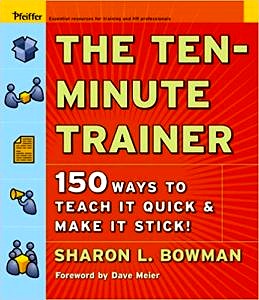Take a Stand! Connecting Learners to Learners and Learners to the Topic

For a topic-related discussion activity that includes lots of movement and that can be used with any content and any group of learners, experiment with “Take-a-Stand” the next time you teach or train.
What Is Take-a-Stand?
In traditional training sessions, learners remain seated while participating in small group discussions about topic-related issues. With the activity called “Take-a-Stand,” learners move around the room and choose designated places to stand before engaging in small group discussions. In effect, the activity includes kinesthetic (movement) and spatial (visual) ways of learning as well as linguistic (verbal).
Take-a-Stand also encourages learners to use higher order thinking skills (analysis, evaluation, synthesis), as they discuss their own perceptions and opinions of questions, issues, or concepts related to what they are learning.
Basically, one side of the training room represents one topic-related issue, problem, statement, or viewpoint and the other side represents the opposite (the sides can also represent “strongly agree/strongly disagree” with the middle of the room representing “undecided or need more information”). Learners stand and move to one side or the other (or anyplace in between) to represent their own opinions, feelings, or choices about a topic-related statement or issue. They discuss their choices with those around them. They can also take turns commenting about their choices in a whole group discussion.
What Does Take-a-Stand Do?
By participating in this activity, learners will:
Recognize important, topic-related concepts and issues.
Analyze their own perceptions of these concepts and issues.
Take an instant position on a topic-related issue.
Refine their own opinions based on the small group discussions about the concepts and issues.
Evaluate the perceptions and opinions of others and whether or not these will be useful to know.
Synthesize what they’ve discussed into new ways of perceiving, thinking, and acting.
Use both kinesthetic (movement) and spatial (visual) learning to increase retention.
Build positive social and psychological connections among small groups.
Strengthen the learning community of the class in a positive, low-risk way.
Getting Ready:
Materials: Instead of just explaining what each side of the room represents, you may also want to give learners that information in written form. If so, you will need wall charts or computer slides.
Set-Up: Make sure there is enough space in the room for participants to move to one side of the room or the other, or in-between (for example, large aisles and empty side areas). A large breakout area in the back of the room or hallway would also suffice.
Group Size: To make the activity worth the time (for movement and discussion), the minimum size group should be about a dozen. There is no maximum limit.
Time: 5 – 15 minutes. With only five minutes, do one Take-a-Stand, with one topic-related statement or issue. Keep the processing time at the end fairly short (a 60-second “Shout-Out” works fine). For the 10- or 15-minute version, you can fit in two or three Take-a-Stand rounds with more than one topic-related statement or issue. Learners move quickly for each statement, and discuss each choice with a 2-minute “Pair-Share.” You lead a short, whole group discussion at the end of all the activity rounds.
Take-a-Stand Instructions:
Explain to the learners what each side of the room represents. Examples are: strongly agree, strongly disagree (for topic-related opinion statements); lots of experience, a little experience (for job-related statements such as use of technology or specific job skills); resident experts, experts-in-training (for experienced employees and new-hires); yes, no (for simple questions). The middle of the room can represent “undecided,” “need more information,” “it depends,” or “middle-of-the-road.”
Tell learners that they will stand up and move to the side of the room that most represents their perception or opinion about the stated issue, or their answer to your stated question. Then tell them the issue, question, or statement.
For example, in a customer service training an issue might be: “A customer complains to you about service by another employee.” A question might be: “Does this situation describe poor, adequate, or excellent customer service (name the situation)?” A statement might be: “The best way to handle poor customer service is to fire the employee who is responsible.”
Once all learners are standing in their chosen places, instruct them to form small standing groups and discuss why they chose to stand in this particular spot. They can also share their own perceptions and opinions of the choices they made.
Debrief the whole activity by asking for comments from both sides and from those standing in the middle. You can also debrief the activity by alternating sides (first a comment from one side, then from the other, etc.).
If time allows, have standing groups reform into mixed small groups, with each side represented within each group. Have the mixed groups continue the discussion for a few minutes longer.
When learners return to their seats, they (or you) can summarize some of the important points from the small and large group discussions. Or they can take a minute or two to do a “Think-and-Write” about what they learned from the activity.
Take-a-Stand Variations:
On a Scale of 1 – 10: The space between each side of the room can be a continuum from one extreme to another. For example: one side stands for the number 1 (“I don’t know anything about this topic”) and the other side for the number 10 (“I know everything there is to know about this topic”). Participants can stand anywhere on this continuum from 1 – 10.
Four Corners: Instead of using the room’s two sides to represent topic-related statements, you can use the room’s four corners. For example, the corners stand for “strongly agree, strongly disagree; moderately agree, moderately disagree.” The middle of the room stands for “I haven’t decided yet.” Or the corners stand for four jobs, four levels of experience, four issues (“stand by the most important one”), or four concepts to learn more about (“stand by the one that interests you the most”).
Take the Pulse: To check how the learners are feeling about an issue, ask them to stand on the side of the room that best represents their feelings: strong feelings about this versus no feelings about this. Or to check how they are feeling about the training, the sides could represent “all is well – carry on” versus “stop and talk – I have some concerns.”
***************************************
 From:
From:
The Ten-Minute Trainer: 150 Ways to Teach It Quick and Make It Stick.
Available on Amazon.com.
For more about Sharon’s books, click HERE.
For the calendar of public TBR classes for 2019, click HERE. For a description of the 2-day “Training from the BACK of the Room” Practitioner Class and the 1-day Trainer Certification Course, click HERE.
For infographics and blog posts with other free resources, click HERE.